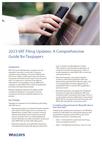2023 VAT Filing Updates: A Comprehensive Guide for Taxpayers
The Federal Inland Revenue Service (The Service) in its bid to drive voluntary tax compliance through tax automation has introduced additional features to the Value Added Tax (VAT) filing module on TaxPro-Max. These modifications are intended to adjust the processes of claiming INPUT VAT, passing sales adjustment entries, and categorizing sales for OUTPUT VAT.
With this recent development, taxpayers are now required to also play a crucial role in ensuring compliance by providing at the point of filing their VAT returns, relevant information about the persons (Customers and Vendors) with whom they transacted with. It is important to state that if the relevant information is not provided, it may be difficult for taxpayers to claim INPUT VAT on both local/domestic purchases and imported purchases.
While the legislative basis for this additional VAT compliance obligation to taxpayers cannot be ascertained, the Service remained resolute in its position.
Key Changes
Taxpayers are required to do the following when filing their VAT returns.
- Download, populate, and upload the Sales schedule with relevant information such as customers’ tax identification number (TIN), customers’ names & address, description of the transactions and the amount invoiced. This is to enable beneficiaries whose information has been provided to access and claim INPUT VAT on their TaxPro-Max portal.
- Download, populate, and upload Purchase (local and imported) schedule with relevant information such as vendors’ tax identification number (TIN), vendors’ names & address, description of transaction and the invoiced amount. This is to enable taxpayers to claim INPUT VAT on local and imported purchases.
- Download, populate, and upload schedule of Sales on which Value Added Tax (VAT) was deducted by appointed VAT collection agent. This is to accommodate necessary adjustments to sales/OUTPUT VAT to ascertain VAT payable for a particular month.
- Download, populate, and upload the schedule of Purchases on which Value Added Tax (VAT) was withheld and VAT remitted by self-charge. This is to accommodate necessary adjustments to purchases/INPUT VAT for the purpose of ascertaining the total INPUT VAT claimable for a particular month.
Compliance Requirements for filing VAT returns from June 2023
Following the new features introduced to the VAT filing module on TaxPro-Max, the under-listed steps are now required from taxpayers and the FIRS as part of the compliance process on a monthly basis:
- Step 1 - Transactions for a particular month (e.g., June) are treated as month 1.
- Step 2 - The following month (e.g., July 1st to July 21st midnight) is the required period for filing returns for month 1 transactions by the taxpayer.
- Step 3 - The subsequent month (e.g., August 1st to August 31st) is adopted by the FIRS for manually tracing INPUT VAT claims that TaxPro-Max cannot verify. This requires verifying the information populated and uploaded by taxpayers on TaxPro-Max in the process of filing.
- Step 4 - Suppliers traced by FIRS, based on information uploaded by taxpayers must comply immediately.
- Step 5 - The month following the manual tracing (e.g., September 1st to September 30th) involves closing cases of unverified claims by the Service. The unremitted VAT (i.e., INPUT VAT claimed by taxpayers) are raised as additional liabilities with penalties and interests in the TaxPro-Max account of identified suppliers.
The Service will also initiate audit and enforcement actions on the suppliers if the established liabilities are not settled within a specified timeline.
If suppliers cannot be traced, INPUT VAT claimed by taxpayers will be disallowed unless the claimant can assist FIRS in locating the supplier within the stated timeline.
Our concluding remarks
The new method of filing VAT returns has imposed additional compliance responsibilities on taxpayers who are now required to do the following:
- Ascertain the compliance status of their customers and vendors before transacting with them.
- Ensure that the VAT deducted from their invoices are remitted as a basis for claiming INPUT VAT.
- Provide accurate information about their transacting parties.
- Give a detailed analysis of their sales and purchases to facilitate auto VAT credit on the beneficiary’s TaxPro-Max page.
Considering that the legal framework of VAT has not been amended, it is expected that the Service would make recommendations in future amendments through the Finance Bill 2024 to accommodate the changes already introduced.

